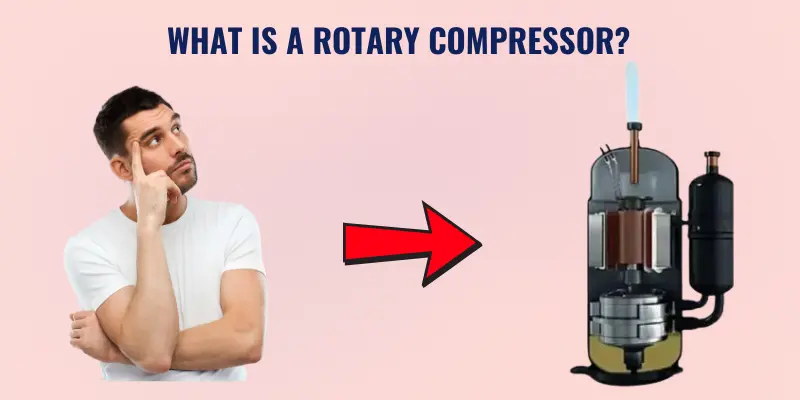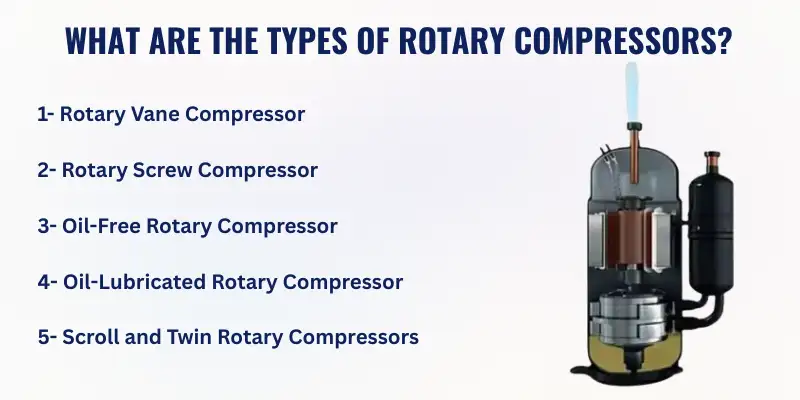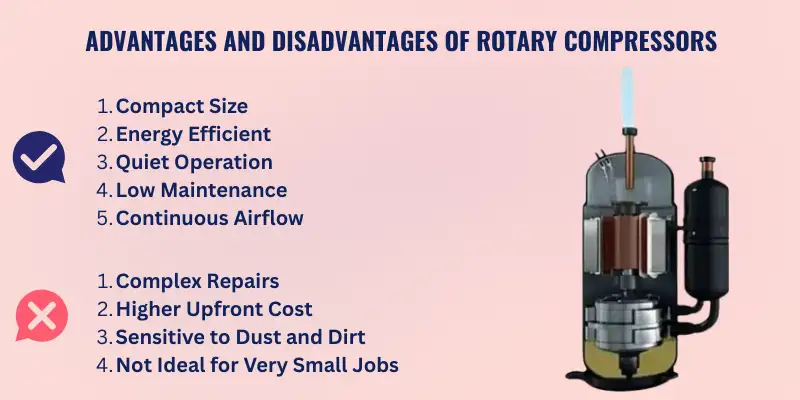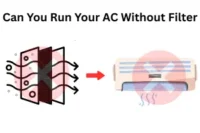What Is a Rotary Compressor? Working Principle, Types, Advantages and Disadvantages
Published: 20 May 2025
Have you ever used a machine that made too much noise or kept breaking down? Maybe it was an old air compressor that took forever to do its job. That can be annoying, right? I’ve seen it too, and it’s not fun when you’re just trying to get something done.
A rotary compressor helps fix that problem. It’s a type of machine that pushes air smoothly and steadily. It works quietly and doesn’t stop often so you can count on it. Keep reading if you’re curious how it works or why it’s better. I’ll explain everything step by step.
What is a Rotary Compressor?
A rotary compressor is a machine that squeezes air into a smaller space to make it more powerful. It uses rotating parts like gears that spin and trap the air, then push it out with pressure.

Why does this matter? Many tools and machines—from air conditioners to factory equipment—need strong, steady air. Rotary compressors help make that happen without making too much noise or breaking down a lot. They’re built to run for long hours and stay cool and efficient, which is why they’re used in so many places, big and small.
Working Principle: How a Rotary Compressor Works
Alright, let’s break it down. A rotary compressor works by trapping air between two spinning parts—usually shaped like screws or blades—and squeezing it smaller as it moves along. Think of it like squeezing toothpaste out of a tube, but instead of your hands, the compressor’s moving parts do all the work.
When the parts spin, they pull air inside. As they keep turning, they push the air into a smaller and smaller space. And when the air has nowhere else to go, it shoots out with a lot of pressure, ready to power whatever machine needs.
It’s pretty clever. It’s steady and straightforward and doesn’t need a lot of noisy banging like other compressors.
Key Components Of Rotary Compressor & Their Functions
Let’s take a closer look at what’s actually inside a rotary compressor. It’s not packed with many parts, but the few it has do some pretty important work. Here’s a breakdown in plain words:
1- Rotors
These are the stars of the show. Rotors are the spinning parts—usually shaped like long screws or blades—that pull in air and squeeze it tight. As they turn, they trap air and move it along the chamber, making it more and more pressurised. Without the rotors, nothing happens. They’re what keeps everything moving.
2- Housing
This is like the outer shell. It holds the rotors in place and keeps the air from escaping too soon. It also helps guide the airflow from where it comes in to where it needs to go. Think of it as the case that ensures the action stays on track.
3- Bearings
Bearings help the rotors spin smoothly. Without them, you’d get a lot of rubbing and friction, which would wear things out fast. So, in a way, bearings are like the quiet helpers, ensuring everything inside runs smoothly and doesn’t break down too soon.
4- Inlet & Outlet Valves
These act like doors. The inlet valve lets air in, and the outlet valve sends the high-pressure air out. They open and close at the right time to keep the process running smoothly. Not too soon, not too late.
What are the types of Rotary Compressors?
Now that you know the basics, let’s discuss the different kinds of rotary compressors available. They might all spin and squeeze air, but they do it differently. Here’s what you need to know (and don’t worry—I’ll keep it simple).

1- Rotary Screw Compressor
This one’s super common, especially in factories and workshops. It uses two long screws that spin together, trapping air between them. As the screws turn, the space between them gets smaller, squeezing the air tighter and tighter. If you need steady air for a long time, like all day, this is what you want.
2- Rotary Vane Compressor
Instead of screws, this compressor uses a spinning drum with little vanes (kind of like flat blades) inside. As the drum spins, the vanes slide in and out, trapping air and pushing it into a smaller space. It’s great for jobs that need a steady but not super-high pressure.
3- Scroll and Twin Rotary Compressors
These are a bit fancier. Scroll compressors use two spiral-shaped pieces, and as one moves, it squashes the air inside. Twin rotary compressors, like their name says, have two rotating parts that work together. They’re quiet, smooth, and often used in air conditioners and fridges where you don’t want noise.
4- Oil-Lubricated Rotary Compressor
These compressors use oil to keep the moving parts cool and running smoothly. They last longer and can handle heavier jobs, but you must do regular oil checks and maintenance. If you’re running big machines, this is usually the better choice.
5- Oil-Free Rotary Compressor
No oil inside these! Instead, they use special materials that don’t need lubrication. They’re cleaner (no oil mist in the air) and better for industries like food, medicine, or anything where clean air is necessary. They don’t last as long as oil-lubricated ones, but sometimes that’s a fair trade.
What Makes Rotary Compressors Unique?
You might wonder, “Okay, but what’s so special about rotary compressors?” A few things make them stand out—and once you notice them, it’s hard to go back to other types.
- They’re compact. Rotary compressors don’t take up a ton of space. You could fit one in a corner of a workshop or tuck it inside a machine without feeling like a giant metal monster taking over the room. For people who don’t have a lot of space to waste (and really, who does?), that’s a big deal.
- They’re quiet. It is surprisingly quiet compared to piston compressors that bang and clatter. Sure, you’ll hear a hum or a light whirr, but it’s nothing that drowns you out. You know why this matters if you’ve ever tried to talk over a loud compressor.
- They have fewer moving parts. Fewer parts mean fewer things that can break. It’s like having an uncomplicated bicycle instead of a complicated motorcycle—less can go wrong, and when it does, it’s easier to fix. Whether running a small shop or just wanting something reliable at home, that’s a win.
So yeah, rotary compressors aren’t just another tool—they’re built smarter, making them different.
Advantages and Disadvantages of Rotary Compressors
Like anything, rotary compressors come with their own set of pros and cons. Let’s keep it real and break it down in simple points:

| Advantages |
|---|
1– Compact Size: They don’t hog space. They can easily be fitted in small workshops or inside machines. 2- Quiet Operation: No loud banging or clanking. Just a soft hum while they work. 3- Continuous Airflow: They deliver a steady stream of air, perfect when you need non-stop power. 4- Low Maintenance: With fewer moving parts, there’s less to wear out, which means fewer repairs. 5- Energy Efficient: Rotary compressors can save you money on energy bills over time, especially at full load. |
| Disadvantages |
|---|
1- Higher Upfront Cost: They usually cost more than basic piston compressors when buying them. |
Conclusion
In this article, I explained a rotary compressor and its importance. You learned how it works by using spinning parts to trap and squeeze air. I also explained the main components—like the rotors, housing, bearings, and valves—so you could see what’s happening inside.
Then, I walked you through different types, like rotary screw, vane, scroll, and even oil-free compressors. You also learned what makes them special: they’re compact, quiet, and don’t have many parts that can break.
Finally, I have helped you understand the main advantages and disadvantages so you can decide if a rotary compressor is right for you.
If you’re tired of noisy, clunky compressors that constantly break down, a rotary compressor could be a more intelligent choice. It’s quieter, runs more smoothly, and doesn’t need constant fixing. Plus, it’s great if you need air flowing nonstop for hours.
Yes! You’ve got options like rotary screw compressors (great for factories), rotary vane compressors (for steady but smaller jobs), and even scroll and twin rotary compressors (perfect for quiet places like homes or offices). You can also choose between oil-lubricated and oil-free types depending on your needs.
Rotary compressors are compact compared to older styles. You can easily fit one into a corner or inside a machine without losing a ton of room. Plus, they don’t add much noise to the space, which is a big win if you work somewhere small.
If you take care of it, a rotary compressor can last 8 to 15 years—sometimes even longer. Regular maintenance, keeping it clean, and not overworking it make a difference. Treat it right, and it’ll last a long time.

- Be Respectful
- Stay Relevant
- Stay Positive
- True Feedback
- Encourage Discussion
- Avoid Spamming
- No Fake News
- Don't Copy-Paste
- No Personal Attacks

- Be Respectful
- Stay Relevant
- Stay Positive
- True Feedback
- Encourage Discussion
- Avoid Spamming
- No Fake News
- Don't Copy-Paste
- No Personal Attacks





